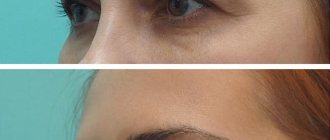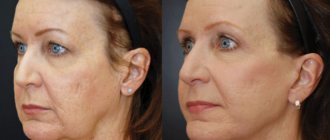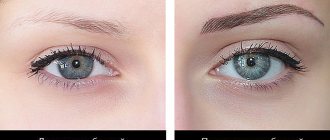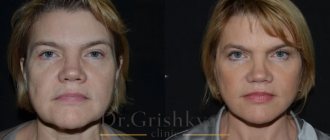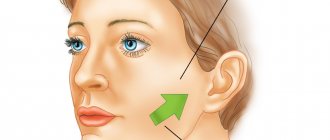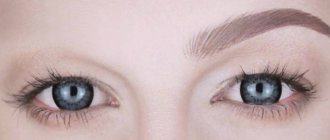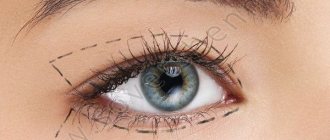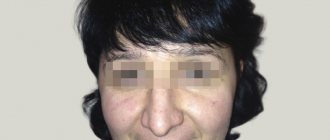IndicationsEndoscopic correctionAdvantagesForehead correction with endotinsSpecifics of the recovery period
Possible complications Reviews Questions and answers Who to sign up for Prices
Local facial plastic surgery is gaining increasing popularity. Unlike total circumferential lifts, they are completely safe and do not require long-term rehabilitation. To correct the upper area of the face, we offer several techniques, which are selected based on individual indications.
Indications for brow lift
Aesthetic surgeons recommend lifting the upper part of the face:
- when sagging, sagging skin appears (including on the temples);
- drooping eyebrow line (both along the entire length and in the inner or outer part);
- downward displacement of the outer corners of the eyes;
- pronounced wrinkles, folds localized in the forehead and bridge of the nose;
- age-related ptosis, tissue deformation or genetically low eyebrows and heavy eyelids;
- facial network of wrinkles around the eyes (it is effectively eliminated when using the temporal lifting technique).
The main goals of plastic surgery in the upper third of the face are:
- Forehead lift
- Eyebrow lifting
- Eyelid correction
Today, traditional “open” plastic surgery is gradually becoming a thing of the past. They are being replaced by complex minimally invasive interventions that can produce better results while simultaneously reducing risks and reducing the duration of the rehabilitation period.
Let's look at the most promising modern methods of anti-aging plastic surgery of the upper face, which allow you to tighten the forehead, lift the eyebrows and rejuvenate the look by removing the sagging of the upper and/or lower eyelids.
Need a consultation?
Forehead and eyelid lift - a complex minimally invasive surgery
All photos of lifting results
Patients often do not realize how drooping eyebrows age them; they give their face a tired, angry or perpetually dissatisfied look. Often people turn to a plastic surgeon for blepharoplasty, although another operation is required - a forehead lift and eyebrow lift.
Go to the mirror and try to pull your skin up a little. Have you noticed how your eyes have changed, your eyelids have stopped drooping, and your face has acquired a more optimistic expression? This is exactly the effect that forehead plastic surgery gives.
Typically, the need for this operation arises in patients over 35 years of age (forehead and eyebrow lifts are popular not only among women, but also among men), but in some cases (for example, if you have naturally heavy eyelids or deep-set eyes), this procedure is resorted to and very young people.
Often eyebrow and eyelid correction is performed as one complex operation. This approach has its advantages:
- Simultaneous lifting gives the most complete and natural effect, as all signs of aging are eliminated without exception.
- This operation can be done in a minimally invasive manner without unnecessary incisions, the risk of nerve damage and the need for long-term rehabilitation. After a week, the patient can return to his normal lifestyle!
How is a brow lift with simultaneous eyelid correction performed?
Photo: Dr. Bely’s original technique is used.
Upper blepharoplasty and brow lift are performed through one small incision in the crease of the upper eyelid. In terms of complexity and trauma, this complex plastic surgery is practically no different from classic eyelid lifting and at the same time is much less invasive than traditional surgical correction of the forehead, which is done through a long incision along the hairline. Of course, a complex eyelid and eyebrow lift operation is much simpler and easier than two separate ones (we mean blepharoplasty and forehead lift).
Contraindications and possible postoperative complications
Contraindications to most plastic manipulations are:
- diseases of the cardiovascular system;
- arterial hypertension;
- blood diseases;
- diseases of the endocrine system;
- infectious diseases;
- malignant neoplasms.
Complications are: numbness of the forehead and temples, inflammatory changes on the face, displacement of the hair growth line, infectious complications.
Watch a video about frontal endoscopic lifting:
Endoscopic correction of forehead and eyebrows
If eyelid correction is not required, an endoscopic forehead lift is performed. This method is also called “no-incision surgery”, since the intervention is carried out through punctures of a few millimeters and leaves virtually no traces. The endoscopic method at one time became a real breakthrough in facial plastic surgery, and now this procedure is a common daily practice, which has almost completely replaced the classic method of open surgery with a bicoronal incision, which leaves a long scar along the hair growth from ear to ear.
As we have already said, an endoscopic forehead lift is performed without classic incisions and excision of excess skin tissue. Instead, plastic surgeons perform detachment surgery and then move and fix the soft tissue in a higher position. Small punctures through which endoscopic instruments are inserted are placed in the scalp, so there is no need to worry about noticeable scars.
Despite the fact that endoscopic surgery is performed without incisions, the surgeon has a clear view of everything that is happening in the surgical field thanks to a tiny camera that is inserted through a separate puncture. The image is enlarged and transferred to a large screen.
Thanks to the advent of endoscopic techniques, it was possible not only to completely rid the patient of scars and reduce the duration of the recovery period, but also to reduce the risks of postoperative complications such as innervation and vascularization disorders.
Endoscopic front lift
Endoscopic forehead and eyebrow lifting is performed under general anesthesia and is completed within 1-4 hours, depending on the amount of work. Endoscopic lifting can be recommended for patients of all categories. The exception is for persons with very deep forehead wrinkles, pronounced ptosis of the eyebrows, and a high forehead. Endoscopic face lifting is the main method of choice for the correction of wrinkles in balding men.
Method of performing the operation: several incisions (up to 5) about two centimeters long are made in the temporal and frontal areas in the immediate vicinity of the hairline. Through them, endoscopic instruments are introduced, which dissect certain muscles responsible for the formation of longitudinal wrinkles on the forehead, and also raise the eyebrows to the required level and are fixed. Thanks to the use of endoscopic instruments, quick and precise execution of the task is achieved, thereby reducing the risk of developing serious complications and the amount of possible blood loss.
Its main advantages are low invasiveness, low risk of complications, high efficiency and visible results, quick recovery.
Endoscopic forehead lift, lower blepharoplasty
Forehead correction with endotins
Endoscopic forehead lift surgery can be performed using endotins. These are thin, absorbable strips equipped with sharp teeth to secure tissue (see detailed information on the use of endotins in facial plastic surgery).
Endotins make it possible to solve the problem of reliable and uniform tissue fixation without overload and the risk of tearing inherent in point fixation. Otherwise, the operation is the same as a regular endoscopic forehead lift.
Lifting using endotins
Facelift using endotins is an endoscopic method, therefore it has virtually no contraindications and has a wide range of applications. The procedure is performed under general anesthesia and lasts about half an hour. The essence of the technique is to install very thin absorbable plates through mini-incisions, which have guide immobilizer spikes. On average, six months after the operation, complete resorption of endotins occurs, and the collagen fibers formed in their place provide a lifting effect for a long time. The main advantages of this operation are:
- precise and reliable fixation of plates;
- minimal risk of complications due to the low invasiveness of the operation itself;
- complete resorption and elimination of the drug from the body within six months;
- no risk of developing rejection reactions or allergies;
- fast recovery period.
Today, this method of facial correction has virtually no disadvantages.
Read more about the use of endotins here.
Specifics of the recovery period
The duration of rehabilitation, the rate of subsidence of swelling and hematomas depend on the technique used, the volume and complexity of the correction. On average, soft tissue recovery takes 2 weeks. Loss of sensitivity may persist for up to 3 weeks, but it goes away on its own without additional treatment.
If the surgical approach was carried out using incisions and subsequent suturing of the wound, the sutures are usually removed after 10 days. Limitations after surgical brow lift (within 1 month) are:
- intense sports, increased physical activity;
- insolation;
- alcohol, smoking;
- thermal procedures and mechanical effects on the operated area.
Sometimes a special elastic tape is applied to the correction area (for up to 3 weeks) to fix the displaced tissues and secured in a new position. Individually, according to indications, medicinal antibacterial therapy and painkillers may be prescribed to prevent inflammatory lesions and relieve pain.
Restrictions
After plastic surgery, patients should always follow certain rules. After a brow lift, you should not use a scrub or do home peeling. Any cosmetic procedures, if they are not agreed with me, will be prohibited during the entire rehabilitation.
In the first months, under no circumstances should you go to the solarium or sunbathe on the beach. Face protection from the sun is necessary. Steaming procedures that heat the body are also not worth doing at first. After surgery, you should not use shampoos and scrubs on the scalp or wash your hair.
Possible complications after a brow lift
Negative postoperative consequences are usually associated with insufficient qualifications of the doctor who performed the correction, or patients’ failure to comply with recommendations during rehabilitation. May occur:
- feeling of pain, numbness in the forehead area;
- change in symmetry, unnaturalness of facial movements;
- damage to nerve endings;
- hair loss and impaired hair growth;
- scarring or infection of the suture.
When surgical lifting is performed correctly, the percentage of complications is minimal (about 1%), and the aesthetic result (a rejuvenated, open face) completely transforms the patient.
Forehead lift, eyebrow lifting and eyelid correction are available not only to Moscow residents. Patients come to us from Perm, Volgograd, Rostov-on-Don, Voronezh, Yekaterinburg, Kazan, Krasnoyarsk, Nizhny Novgorod, Novosibirsk, Omsk, Samara, Ufa, Chelyabinsk and other cities throughout Russia.
Forehead, eyebrow and eyelid lifts can be performed in various ways in our clinic. The specific technique is chosen by the plastic surgeon based on existing indications and taking into account the wishes of the patient. These operations at the DOCTORPLASTIC clinic are performed not only by leading Russian facial plastic specialists, but also by such stars of world plastic surgery as Professor Samuelsson, President of the Swedish Association of Plastic Surgeons.
Contraindications to browlifting
Like any surgical intervention, eyebrow plastic surgery has contraindications . These include the following conditions:
- pathologies of the heart and blood vessels;
- disorders of the thyroid gland;
- infectious diseases;
- disruption of internal organs;
- the presence of tumors in the body;
- blood clotting disorder;
- severe skin lesions;
- low elasticity of the epidermis.
If contraindications are ignored, serious complications may develop, so you must make sure that they are absent.
Preparation
In preparation for a coronary forehead lift, a standard list of tests is taken:
- blood (general, biochemistry, group, Rh, coagulability, HIV, syphilis, hepatitis);
- urine (general).
It is also necessary to do an electrocardiogram, X-ray or fluorography of the chest, and ultrasound of the veins of the lower extremities. A consultation with our anesthesiologist is required, who will decide on admission to the operation and the type of pain relief that is safest taking into account the patient’s health condition.
Photos before and after operations
For many ladies, the main life principle is that until I see it with my own eyes, I won’t believe it. We will try to convince our readers of the effectiveness of the procedures, and we invite you to look at photos of eyebrow lifting. This will not only help make sure that the technique really effectively gets rid of defects, but will also prove that modern cosmetology is capable of a real miracle - restoring youth.
You should not wait until the defects on your face are so obvious that even tons of cosmetics cannot hide them. Eyebrow lifting is a technique that will help you forget for a long time that youth is not eternal and will allow you to enjoy the blooming appearance of your face in the mirror. After simple and short manipulations by the surgeon, wrinkles will become a thing of the past and will become only unpleasant memories.
About scars after broupexy
During temporal eyebrow lifting, special attention, as always during plastic surgery, is paid to markings: the area of the operation and the location of the incisions and removal of the skin flap are noted. The future result directly depends on this stage, so it is extremely important. During an endoscopy or local temporal lift, the surgeon removes a flap of skin along the edge of the hair growth: thanks to this, visible scars can be avoided, which is undoubtedly a huge plus for the patient. The surgeon fixes the eyebrow in the new position and carefully closes the incisions with threads made of absorbable material. At first, the scar can be easily covered with hair, and after a few months it will be invisible even with your hair tied up. With direct browpexy, the scar will be hidden in the hairs of the eyebrow.
How to raise eyebrows without plastic surgery
If the patient wants to do without surgical eyebrow lifting and is interested in more gentle methods, then a transformation in the cosmetologist’s office is possible. It will be temporary and not as effective, but there will be small changes. What is a brow lift called in cosmetology? Non-surgical browlift.
There are different methods to fix the problem. A thread or ligature brow lift is used: the cosmetologist works in this area with special absorbable threads. Injection methods can also be used: eyebrow contouring with special fillers based on hyaluronic acid, botulinum therapy. Hardware techniques will also be relevant. Often, a cosmetologist can combine several methods in order to obtain the desired result. But it is worth noting that in case of pronounced problems, plastic surgery (brow lift) will definitely be the most relevant.
Rehabilitation after broupexy
After eyebrow lifting with plastic surgery, it is especially important to take into account all the restrictions and recommendations that the surgeon prescribed: exclusion of physical activity, visiting baths, saunas, solariums and exposure to the sun. Particular attention is paid to care and hygiene, attending all examinations and dressings. Their schedule and duration of restrictions depends on the broupexy technique, among other things.
Despite the fact that the effect of the tightening will be noticeable immediately, it is best to evaluate the result after a month: due to swelling, the picture will be inaccurate.
A correctly selected browlifting technique will help to obtain a pronounced rejuvenation effect and get rid of many problems that bother the patient - a “gloomy and heavy” look, wrinkles in the forehead, eyebrows, etc.
Transform yourself with pleasure together with the specialists of the Etalon clinic!
Let's sum it up
Brow lift with threads is a procedure that really works. This is a great way to remove drooping eyelids, lift eyebrows and visually “open” your eyes: without surgical interventions and long rehabilitation.
The procedure takes no more than an hour, and the effect lasts up to 2 years. Eyebrow thread lifting is suitable for patients from 30 to 50 years old. There is no point in doing the procedure later: the effect will not be impressive.
Eyebrow transplant
There are many methods for creating perfect eyebrows, but the most natural one is only a transplant.
When eyebrows are too thin or, on the contrary, thick, the appearance of the face changes for the worse. To correct this, hair transplantation is used; it corrects the shape naturally. First of all, eyebrow transplantation is a quick and aesthetic procedure for people who have problems with the shape or thickness of their natural eyebrows. Naturally, people with similar problems want to change their eyebrows.
Hair transplantation looks natural if the material is taken from the back of the head. The hairs taken for transplantation must have the same thickness as natural eyebrows. For the procedure, hairs are selected from the ears or neck area . Follicles with no more than 2 hairs are used.
The purpose of transplantation is to take hair follicles from donor areas and transplant them into the recipient area. The number of grafts for the procedure depends on the initial condition of the eyebrows; generally, they need from 50 to 350.
The procedure for collecting hairs for transplantation and their implantation is carried out under local anesthesia, so the process is almost painless. But, as soon as the anesthesia wears off, unpleasant or painful sensations may occur, which completely disappear after a few days.
Indications and contraindications for
Indications for the operation include:
- Hair loss caused by burns, tattooing, trauma, chemotherapy, stress.
- Complexes and dissatisfaction with appearance.
- Irreversible eyebrow alopecia.
- Facial nerve paralysis.
- Hormonal disbalance.
- The need to acquire greater density.
The procedure is performed in order to change their asymmetrical location, hide scars or scars, and give a different shape and density.
The main contraindications to the procedure are:
- Poor blood clotting.
- Allergic reactions to medications (painkillers, without which it is impossible to undergo a transplant.
- Presence of psychological disorders.
- Diabetes.
- Pregnancy and lactation period.
- For very deep and large scars in the eyebrow area. In this case, the likelihood of engraftment is minimal.
- Autoimmune connective tissue diseases (dermatomyositis, scleroderma).
Preparation for the procedure
Hair transplantation is performed by a transplant surgeon.
The preparation is as follows:
- The doctor marks the desired shape and position of the eyebrows.
- Immediately before the procedure, you must undergo an examination and pass all the necessary tests.
- If no contraindications are identified, a day for the transplant is scheduled.
The entire process is carried out with special tools that leave no traces behind. The procedure is performed under local anesthesia (lidocaine administration).
Wounds after surgery heal quickly, leaving no traces. And the eyebrows turn out natural and natural. The transplant is performed using grafts that contain 1-2 hair follicles.
Step-by-step stages of work:
- Designing the desired eyebrow shape according to the patient's wishes. It is calculated how many follicles are needed and where to get them.
- Using a surgical marker, the contours of the eyebrows are drawn and the donor area is highlighted.
- The work area is disinfected, anesthesia is given to the eyebrow area and to the places from which the material will be taken.
- Micro-instruments are used to remove the required number of hairs from the donor area.
- The material is carefully examined under a microscope to select only healthy, high-quality follicles.
- Selected hairs are treated with a special product that promotes their rapid engraftment.
- Small punctures are made in the eyebrow area into which the follicles are placed. They are placed so as to maintain the natural direction and slope.
The time of transplantation depends on the scale of the work. The more hairs need to be transplanted, the longer the operation will be. For complete restoration of eyebrows it will take up to 6 hours, for partial restoration up to 3.
Operation techniques
Eyebrow transplant surgery techniques:
- Tattoo.
- Manual micropigmentation.
- Microblading.
- Powder spraying.
The disadvantages include:
- Wrong outline.
- Loss of eyebrow shape due to destruction of hair follicles.
Patchwork method
- A scalpel is used to separate a strip of fabric along with the hair.
- The resulting fabric is divided into small pieces.
- Afterwards they are transplanted.
The main advantage of the method is that it obtains a large amount of material. Follicles containing several hairs are discarded, since they cannot be implanted. As a result, a scar remains after the procedure, and eyebrow growth will not be natural.
Seamless transplantation technique (STI)
This method involves two options:
- Automatic . The follicles are removed with a mechanical punch, the material is divided into gifta.
- Manual . It is carried out with a special instrument - a punch (a round hollow scalpel). In this method, the follicles are separated and harvested one by one.
Transplantation is carried out as follows:
- A small incision is made in the skin.
- Place the material.
